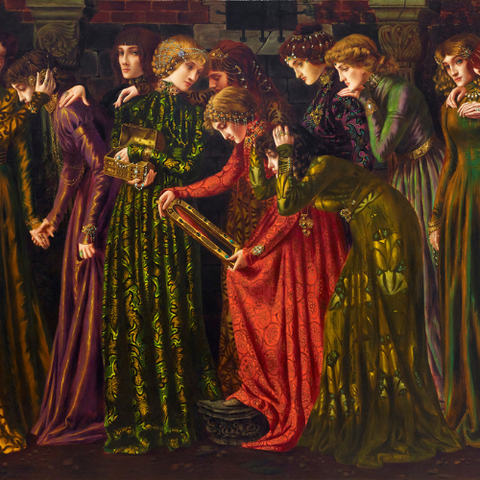M.S. Rau is committed to offering fine art of the highest caliber and we seek paintings and sculpture by historically renowned artists, often with impressive provenance. The large majority of our works of art come from private. . .
At M.S. Rau, we are committed to building a long-term, rewarding relationship with each and every client. That’s why your purchase is backed by our 125% guarantee.
Learn MoreA Spring Roundelay by Edward Atkinson Hornel
- This celebration of the joys of childhood and nature was painted by Edward Atkinson Hornel
- Hornel lived in Scotland for most of his life, and was a part of the famed Glasgow School
- This composition features the lush colors and vibrant subjects for which he is beloved
- Get complete item description here
To speak to one of our experts, call 1-888-711-8084
1864-1933 | Scottish
A Spring Roundelay
Signed “E A Hornel” and dated 1910 (lower left)
Oil on canvas
Visually arresting with the vivid hues of springtime, this uplifting scene of seven young girls romping in a springtime scene was painted by Scottish artist Edward Atkinson Hornel. The delicate pinks of the cherry blossoms match the blushed cheeks of the joyous children, who smile and laugh as they collect spring’s. . .
1864-1933 | Scottish
A Spring Roundelay
Signed “E A Hornel” and dated 1910 (lower left)
Oil on canvas
Visually arresting with the vivid hues of springtime, this uplifting scene of seven young girls romping in a springtime scene was painted by Scottish artist Edward Atkinson Hornel. The delicate pinks of the cherry blossoms match the blushed cheeks of the joyous children, who smile and laugh as they collect spring’s blooms. An homage to the beauty and bounty of nature, A Spring Roundelay features an almost mythic quality, not unlike Hornel’s other compositions of Druids and other Celtic subjects. His painterly strokes, achieved through applications with a palette knife and a scraping process, create an all-over visual stimulation; the cheerful colors and forms blend together, creating a sense of dynamic movement as the girls dance. The resulting oil on canvas exudes a dream-like quality, inviting the viewer to bask in the sentimental wonderment of nature and childhood.
Born in Australia, Hornel was raised in Kirkcudbright, Scotland, where he lived for nearly his whole life. He attended art school at Edinburgh for three years, and for two years at Antwerp under Professor Verlat. Returning from Antwerp in 1885, he met George Henry, a prominent member of the Glasgow School, and aligned himself with the group’s principles. Part of the Art Nouveau movement, the so-called Glasgow Boys taught Hornel how to capture the natural light effects in his compositions, which mainly included figures and landscapes. Hornel was also highly inspired by Japanese art, following an eighteen-month-long trip to Japan with Henry between 1893 and 1894. There, his subjects included geishas and silk markets, allowing the artist to accommodate late-19th and early-20th-century British collectors’ insatiable desires for japonisme and Orientalist art. His inclusion of cherry blossoms, Japan’s national flower that had only been introduced to Britain decades prior, in A Spring Roundelay further underscores this deep admiration and appreciation for Japanese subjects.
This 1910 edition of Hornel’s Spring Roundelay is an earlier version of his celebrated Springtime Roundelay, exhibited at the Royal Academy in 1911 and now residing in the collection of Glasgow Museums. It has been reported that the King and Queen of England, upon seeing the painting at the exhibition, exclaimed to the press, “Everybody who admires pictures should have a Hornel in their home." Nearly identical in composition and execution, the present edition matches the monumental scale and compelling color of the Royal Academy masterpiece.
Painted 1910
Canvas: 30 1/2“ high x 42 1/2” wide
Frame: 37 5/8“ high x 49 1/2” wide x 2 5/8“ deep
Provenance:
W.B. Dickie
Sale, Christie's London, 9 June 1978, lot 171
Ian MacNicol, Glasgow
By descent to private collection
Literature:
Bill Smith, Hornel, The Life and Work of Edward Atkinson Hornel, Atelier Books, Edinburgh, 1997, illustrated p. 118, pl. 63

| Maker: | Hornel, Edward Atkinson |
| Period: | 1816-1918 |
| Origin: | Scotland |
| Type: | Paintings |
| Style: | Post-Impressionism |
| Depth: | 2.63 in. (6.67 cm) |
| Width: | 49.5 in. (125.73 cm) |
| Height: | 37.63 in. (95.57 cm) |
| Canvas Width: | 42.500 in. (107.95 cm) |
| Canvas Height: | 30.500 in. (77.47 cm) |

Truth, Beauty and Tragedy: The Art of the Pre-Raphaelite Brotherhood
Click here to shop the collection of works included in this article. The Twelve Princesses by Gustave-Max Stevens. Dated 1899. M.S. Rau (New Orleans) Luminous color and meticulous detail with...
Read MoreAt M.S. Rau, we are committed to building a long-term, rewarding relationship with each and every client. That’s why your purchase is backed by our 125% guarantee.
Learn More



















